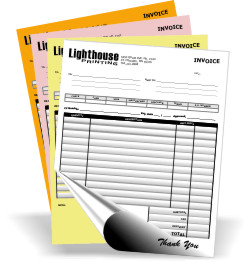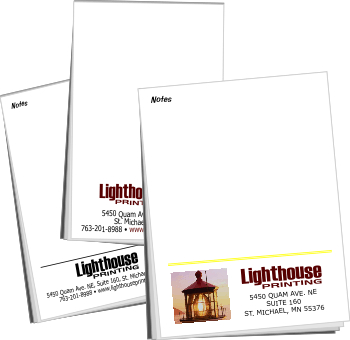What is Carbonless Paper? – December, 2018
Carbonless paper is essentially the same as regular paper, but with an important, defining modification. A sheet of carbonless paper is half carbon-copying mechanism, half carbon-rich paper. It is only different from standard paper when placed beneath a sheet of carbon-rich paper.
To produce the carbon paper, a common industry practice is to heat hydrocarbons to a temperature such that they decompose partially. The carbon residue that remains is called “carbon black.” Normal paper is then rolled around a rod laden with carbon black so that only one side of the paper becomes covered in it.

Neither the carbon-rich paper nor the carbonless paper is especially useful on its own. They are both regular pieces of paper alone. When combined, carbon copying is possible.
With 2-part carbonless paper, when you write on the top white sheet, it transfers to the 2nd yellow sheet, for an exact copy. You can now give one of the sheets to your customer and keep one for your own records. This saves from having to make copies when no copier is available.
Standard paper color for carbonless paper is: 2-part (white/yellow); 3-part (white/yellow/pink); 4-part (white/yellow/pink/goldenrod) and 5-part (white/green/yellow/pink/goldenrod).
Carbonless paper also comes in special paper color sequence such as white/white, white/pink, blue/white, pink/white, yellow/white and more for any custom needs.
The Inventor of Carbonless – Lowell Schleicher – JANUARY, 2019
Lowell Schleicher, whose work with the microencapsulation process led to the invention of carbonless paper. Born in Glenwood Springs, Colo., Schleicher earned a bachelor’s degree in chemistry from Hillsdale College, Hillsdale, Mich., and a master’s degree in colloid chemistry from the University of Michigan.
Schleicher began working with a company scientist at NCR who introduced the first commercial example of a system of liquid-filled microcapsules dispersed within a solid coating. It was this microencapsulation system that was used to develop carbonless paper. During 1952 and 1953 they worked together to further develop and refine the microencapsulation system. They filed for a patent on June 30, 1953.
During the patent application process Schleicher proved he was as capable of explaining his ideas as he was at creating them. “The examiner refused to believe that capsules existed and instead felt the paper contained nothing more than oil and water emulsion,” said Schleicher. “So I put my equipment and materials on his desk and demonstrated the entire process right in front of him.” The patent office approved his application.
How to Get Your Form Ready for Carbonless – FEBRUARY, 2019
Carbonless forms can be prepared in a number of software programs. Most common would be Microsoft Word, Excel, Adobe InDesign and many others. Most printers prefer forms to be uploaded in PDF format. By uploading your carbonless forms orders in PDF format, this ensures that fonts do not change to something that you don’t want and that all line endings and formatting is exactly like how you set it up in your original software. Be sure that fonts are “embedded” when saving your file in PDF format.
Since most carbonless forms are not run on “oversize” paper, a 1/4 or 3/8 inch margin is required on all sides. This means that there needs to be a white border all the way around the edge of your form. The reason for the white space is that the printing press has a “gripper” margin, where the plate is attached to the printing press and no printing can occur above that on the sheet of paper.
If you are requesting additional bindery options, such as 3-hole drilling or perforating your forms at the top or side, an extra 1/2-inch may be required to ensure that the perforation or drilling holes do not cut through any of your words or lines.
Most printers have their artwork requirements posted on their websites. You can find ours with illustrations by clicking here
Running Carbonless Paper in Your Laser Printer – MARCH, 2019
There is carbonless paper specially made to be run in laser printers. You must be certain to print on the “image” side. The reams of paper are marked with an arrow to indicate which side the image should be printed on. Also, your printer may print on the top of the sheet as you place it in the tray or it may print on the bottom. The easiest way to determine is to mark the sheet with an x and print it to see which side your printer picks up and prints the sheets.
Carbonless paper comes precollated, so you must print one sheet at a time, (a 2-part form requires you to print two copies and a 3-part form requires you to print three copies). To print 20 3-part forms, print 60 sheets of paper. The result will be 20 3-part forms.
Remember to design your form with your printer restrictions in mind. Some printers need 1/4 inch margin on all sides, some may need more or less.
To “edge glue” or attach the tops of the sheets to be ready to transfer from the white to the yellow, you may staple, paper clip or you can use carbonless glue. We offer both blank carbonless stock and glue (with a brush to apply the glue) on our site.
Notepad Printing – MAY, 2019
Whether writing, drawing, or making lists – notepads are multi-purpose tools for everyday use. Personalized notepads are great for advertising! Who doesn’t have a notepad by their phone or on their desk?
We offer notepad printing in various sizes and paper types to allow you to personalize your notepad. Small notepad size starting at 4.25″ x 5.5″ (a quarter sheet of letter size paper), in pads of 25, 50 or 100 sheets. Some sizes available on colored stock, or to really make an impression, printed in FULL COLOR. They can have many uses and can be printed on the front side only, or the front and the back if using them for forms.

Thanksgiving – NOVEMBER, 2019
Thanksgiving Day, annual national holiday in the United States and Canada celebrating the harvest and other blessings of the past year. Americans generally believe that their Thanksgiving is modeled on a 1621 harvest feast shared by the English colonists (Pilgrims) of Plymouth and the Wampanoag people. The American holiday is particularly rich in legend and symbolism, and the traditional fare of the Thanksgiving meal typically includes turkey, bread stuffing, potatoes, cranberries, and pumpkin pie. With respect to vehicular travel, the holiday is often the busiest of the year, as family members gather with one another.

Thanksgiving Day did not become an official holiday until Northerners dominated the federal government. Sarah Josepha Hale, of Godey’s Ladybook campaigned for a national Thanksgiving Day to promote unity. She finally won the support of President Abraham Lincoln. On October 3, 1863, during the Civil War, Lincoln proclaimed a national day of thanksgiving to be celebrated on Thursday, November 26.
Happy Thanksgiving and a big “Thank You” to all our faithful and loyal customers. We appreciate your business!
Christmas – DECEMBER, 2019
Christmas Facts
Each year, 30-35 million real Christmas trees are sold in the United States alone. There are 21,000 Christmas tree growers in the United States, and trees usually grow for about 15 years before they are sold.
Today, in the Greek and Russian orthodox churches, Christmas is celebrated 13 to 14 days after the 25th. This is because Western churches use the Gregorian Calendar, while Eastern Churches use the Julian Calendar.
In the Middle Ages, Christmas celebrations were rowdy and raucous—a lot like today’s Mardi Gras parties.
When Christmas was cancelled: From 1659 to 1681, the celebration of Christmas was outlawed in Boston, and law-breakers were fined five shillings.
Christmas was declared a federal holiday in the United States on June 26, 1870.
The first eggnog made in the United States was consumed in Captain John Smith’s 1607 Jamestown settlement.
Poinsettia plants are named after Joel R. Poinsett, an American minister to Mexico, who brought the red-and-green plant from Mexico to America in 1828.
The Salvation Army has been sending Santa Claus-clad donation collectors into the streets since the 1890s.
Rudolph, “the most famous reindeer of all,” was the product of Robert L. May’s imagination in 1939. The copywriter wrote a poem about the reindeer to help lure customers into the Montgomery Ward department store.
Construction workers started the Rockefeller Center Christmas tree tradition in 1931.Merry Christmas and Happy New Year 2020! We thank you for all your 2019 carbonless, flyers, envelope and business card orders!
Looking to increase your visibility and gain exposure for your ideas? – JANUARY, 2020
Everyone is following someone. Maybe it’s time to engage others, so they follow you!
1. Building Connections
Build your engagement quality by cultivating regular contact with close friends and family, with current and former colleagues, or with analysts, writers, or industry leaders.
Engage and follow others through face-to-face networking, regional training opportunities, social media, or online discussion groups. Gain traction as you contribute, follow, share, or add your own commentary to material relevant to your industry. And – as often as you can – share your picture with printed pieces or online content. Matching a face with your voice makes you more memorable, credible, and real.
2. Growing Your Name and Niche
Thought leaders are people who fully immerse themselves in the needs and concerns of their audience.
To stand out from the crowd, concentrate on a niche market or seek to communicate with a specialized group of people. Write, speak, share, and comment on the things most relevant to this area. Think of yourself as a translator (explaining the concerns at hand and interpreting their meaning) or a tour guide (predicting trends, forecasting effects, or helping people interpret what they see). Here you’ll maximize impact, giving people “Aha” moments, or making them think, “Wow, I never thought of it like that!”
Grow your influence by writing articles for publications, requesting to share on panels or policy boards, publishing via social media and printed newsletters, or inquiring about opportunities to speak at events.
Once you establish credibility, you’ll naturally become part of bigger and better opportunities.
What is Full Color Printing? – APRIL, 2021
Full Color is a printing process that combines four colors (cyan, magenta, yellow and black, commonly referred to as “CMYK”) to create full–color images. When printers talk about full color printing this is four-color printing. By using CMYK, the colors available for use are numerous due to the various combinations that can be mixed.
Full color printing will keep someone’s attention longer, causing them to read your printed piece better than only a black and white printed piece.
Tests indicate that a black and white image may sustain interest for less than two-thirds a second, whereas a colored image may hold the attention for two seconds or more.
Full color printing is available for just about anything printed on paper, business forms, envelopes, notepads, flyers, postcards, business cards and more.
Full color printing can be done several ways including “offset” (meaning on a printing press using 4 plates, one for each color), or “digitally”, usually meaning a machine very similar to a color copier or large inkjet printer. Both provide excellent results and beautiful color. Try full color for your next printing project.


